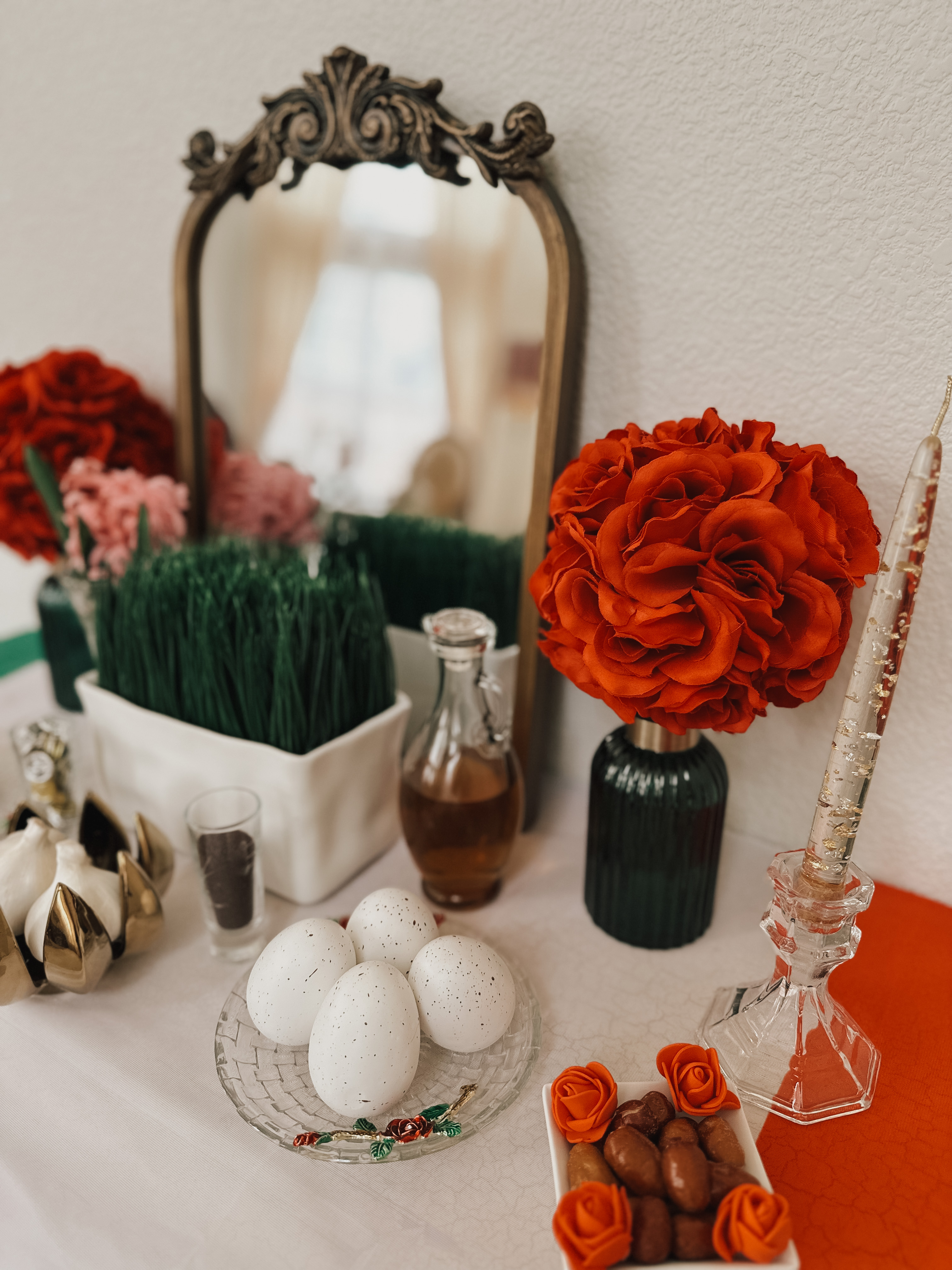Persian New Year 2023 | Norooz 1402
Friday, March 17, 2023 |
| Please feel free to save and/or share this graphic quote to Pinterest, your mobile or desktop screensaver, etc. whether you are a Persian woman or a supporter of us. |
Zan, Zendegi, Azadi (Woman, Life, Freedom)
I incorporated the colors of Iran's flag (green, white & red) and chose roses to be a part of our attire and sofreh to represent the theme "Persian Women Are The Roses of the Middle-East" (Que Andy's lyrics "Dokhtar Irooni Mesleh Goleh"! IYKYK
For those who don't know much about the country of Iran or have been living under a rock these past several months, allow me to provide a mini history lesson, and get a little personal here. Iran is the pinnacle of early civilization, monarchies, poetry, music, religion, art, and traditions. There is so much rich history within this beautiful country; ancient monuments galore and many cities that each offer diverse languages/accents, ensembles, culture, food, and architecture. Much of its beauty however changed due to the reigning Shah (King) being overthrown by the radical and violent regime we all know today. Growing up as the very 1st generation Iranian-American in my family, I was oblivious to the privilege of being born a free female. My parents were fortunate enough to have immigrated prior to the 1979 revolution. As a child, I vividly remember overhearing how many of my family members tried to flee the country after the revolution. Some easily escaped, while others had to take more drastic measures; some even went into hiding before finally reaching the U.S. It was such a huge deal once a family member made it to the U.S. safely; so much joy and celebration was shown to them upon their arrival. I still didn't quite comprehend the extent of why that freedom beared so much weight. It wasn't until I visited Iran myself at age 10, that I personally experienced its vast beauty, and also, the post-revolution struggles placed upon women.
In the summer of 1995 while sightseeing in Tehran, I rode a bus, and was enamored by the sights I saw through the big front windows. I unfortunately (and very quickly) experienced gender segregation - being told women and children were not allowed to ride the front of the bus, ONLY men. I had to move back or I would be arrested. Women were also not allowed to wear nail polish, heavy makeup, show feet/ankles/arms, and of course, had to cover their hair. There are even more restrictions but the list is just far too long to cover in this post. In 110 degree summer weather women had to cover their bodies with long sleeve trench coats that made it down to your ankles, and of course your feet had to be covered too, so pants and socks were a must. Men on the other hand were free to wear t-shirts and shorts, and lucky enough to avoid baking in the extreme heat. At my young age, I couldn't wrap my head around how such a beautiful country with beautiful morals and values, even our beautiful poetic spoken language, could be an ugly hundreds of years still backwards towards the treatment of its women! I saw the pain in my mothers eyes visiting her homeland for the 1st time since she left prior to the revolution. She was shocked, and constantly reminding my brother and I that THIS was NOT her Iran, NOT the Shahs Iran, this was certainly NOT the same Iran. Due to my age, most of those harsh rules did not apply to me, or other young girls....yet.
That was way back in the 90's. Fast forward to 2022 to a world of advancement, and not much had changed in Iran after decades of murders and vile acts towards women. The very same women that give life, whom are the first teachers to infants and children, that shape and educate young minds of cultural values and traditions, and have even served within powerful roles alongside men as Dr's, Lawyers, Judges, Scientists (during the Shah's reign prior to 1979). It wasn't until, Mahsa Amini, yet another young woman murdered by Iran's "mortality police", became the latest symbol of the oppression faced by Iranian women, that finally incurred the highly awaited change. As a result, "Zan, Zendegi, Azadi" and unprecedented outrage across the country was born. The young generation of my people have had enough. They are speaking up, and struggling to make a difference through their peaceful protests to an extremely close-minded backwards government.
I am grateful for my freedom, and I have, and always will be a proud Persian woman. As I mentioned earlier, Persian women are the roses of the Middle-East. Instead of celebrating the great importance our women are to our race, they are being injured, mutilated, and even murdered for using their god-given voice about gaining access to their basic human right to be equally free as Iranian males. I stand with the women (and men) whom also agree with little-10-year-old-bewildered-me about how these unfortunate inhumane travesties have taken far too long, and far too many innocent lives. The tortures and deaths of females/those who support them since the 1979 revolution - that should have never started to begin with - NEEDS TO END NOW...
That is my Norooz wish.
________________________________________________________
Below is a breakdown of items placed on a Haftseen (Haft = 7 and seen - S's - Persian New Year spread w/ 7 symbolic items that start with an S) & their symbolism:



















0 comments